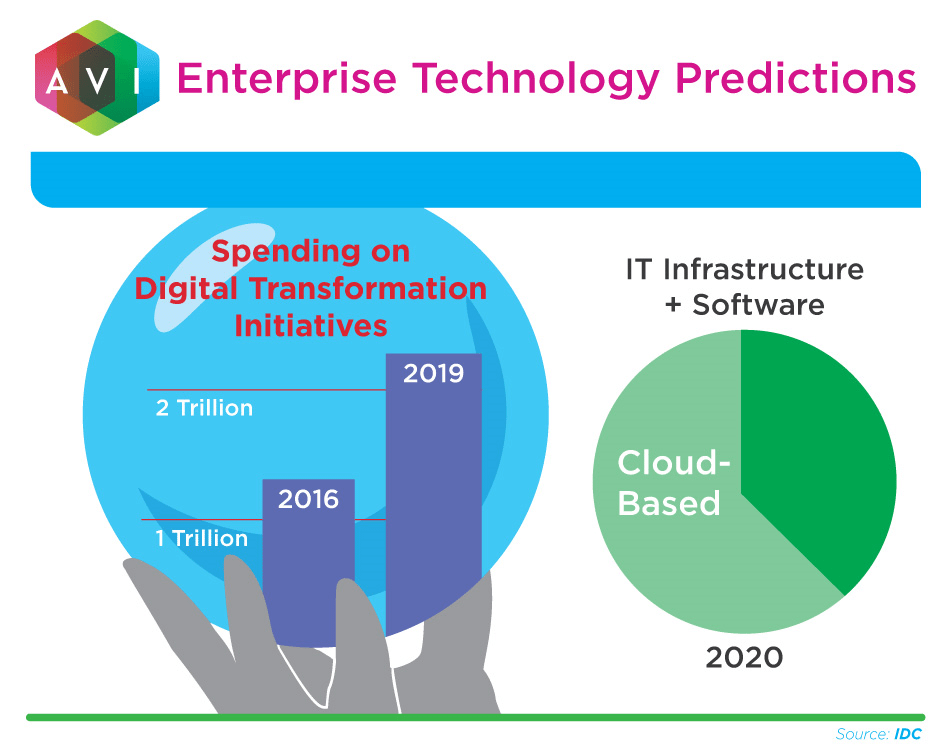The wealth of technologies available to organizations in 2016 often made audiovisual integrations even more complex. Emerging technology trends mean 2017 will leave many seeking to simplify their integrations, while also embracing big changes.
Design Engineer Dave Hatz contributes his thoughts to predictions for the new year. Here are 10 technologies and trends to watch in 2017:
1. The Internet of Things
Everyone has become familiar with the Internet of Things (IOT) and automation and many even expect it in a corporate setting. That includes device recognition, smart building connectivity, voice-commanded virtual assistance, automation, and more. It can extend to recognition of your identity, location, and equipment needs upon entering.
However, with the recent push to include more and more new technologies in our systems, many are saying “enough is enough.”
Some are concerned about unreliability and are starting to ask for integrators to simplify their systems again. The solution, though, is not to reduce the number of widgets or components installed.
The answer is for AV integrators to simplify the process itself so end users can experience a fully functional toolset.
2. Intelligent Systems
In 2017, more companies will adopt intelligent systems. These are systems that learn usage patterns and offer choices as a result of those patterns. They give us information like when the projector lamp’s life will expire. They go beyond basic data analysis and help users apply it to made intelligent decisions for better experiences.
3. Managed Services
Increasingly complex systems mean more companies will want and need help to simplify and to manage them. Integrators like AVI Systems will offer a range of managed services to help organizations make smart decisions and keep systems running smoothly in their day-to-day operations.

4. Employee Mobility
Companies must now consider that everyone on a team or in a partnership may want to work from anywhere. Employees and associates seek independence, and organizations must continue to figure out how to make it so with meeting solutions, content-sharing tools, and personal devices.
5. Security
The aforementioned use of numerous devices and personal ones means existing security concerns will continue to grow. As we predicted last year, security was a greater concern in 2016, but 2017 will see even more complex issues. In fact, many of the other technologies and trends on this list tie into security.
6. Flexible Work Spaces
Huddle spaces and other flexible arrangements continue to be a priority in many environments, including corporate and education. We’ll see more solutions that aim to improve collaboration and make it easier—even at the spur of the moment and with any device and with remote participants. We’ll see more options for employees to work in and out of office as needed, and there will be more behind-the-scenes automation.
7. More Data and Analytics
We are going to continue to see the trend of gathering more data, as well as performing more and more complex analysis to make our systems smarter. This trend will allow customers to make better-informed decisions about usage and investments.
8. Digital Displays Everywhere
Digital signage is now a part of everyday life, and it will become an even bigger part of day-to-day business. They come in every shape and size, and they can be made to stand out or blend in. Increased options with flexibility and wrap-around technologies mean your company can customize the solutions that align with your business goals.
9. Augmented Reality
We may only see the beginning of augmented reality applications in 2017, but there is enormous potential for enterprise, retail, education, entertainment, and more. We know that these kinds of technologies are ideal for training, design, engineering, and testing. It’s certainly something to keep an eye on.
10. Software and Apps
We will always need hardware and devices, but they are becoming increasingly smaller, more flexible, and more unified. That means apps and software will be running much of the show. They’re easier and more affordable to update than boxes and devices, they also make it increasingly difficult to find the right solutions that do everything you want and work with existing systems, as well as future investments.








